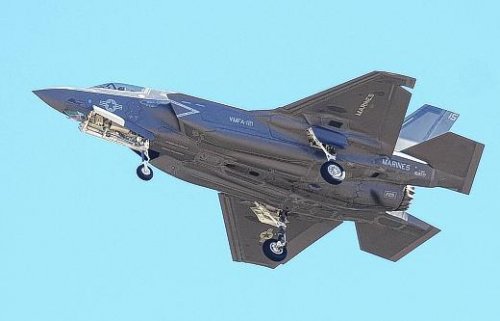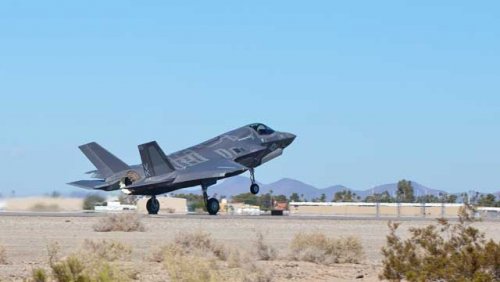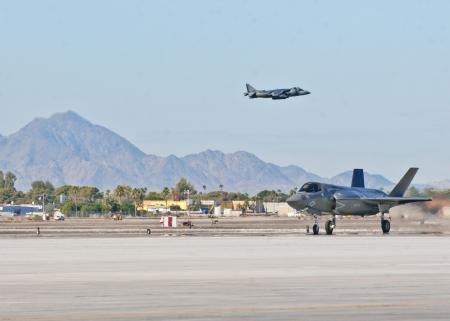The U.S. Marine Corps has received its first F-35 Joint Strike Fighter that, in theory, is meant for actual combat. But that doesn’t mean the pricey, long-delayed JSF is going to be dropping bombs on enemy targets anytime soon. The Lockheed Martin-built plane’s computerized logistical system, flight software and special helmet still aren’t ready — and it lacks weapons.
No, the Marines have taken possession of the combat-designated, but not combat-ready, F-35 in order to begin building up its stealth-fighter fleet. Not yet, anyway. The advance preparation should ensure that the Corps can send the new JSF squadrons into combat the moment the jet is finally fully equipped … whenever that might be.
“The Marines are determined to get this plane into the field as soon as it can be safely accomplished,” Loren Thompson, a Lockheed consultant, told Reuters. “They don’t want to be slowed down by bureaucratic obstacles.” Instead, it’s the technical obstacles that are dictating the timing of the F-35′s combat readiness. No one is sure precisely when the jet will get the critical missing items, but it could be years.
Of all the military branches acquiring F-35s through history’s most expensive weapons procurement effort, the Marines need the stealthy jet the most. The Corps’ existing Hornet and Harrier fighters are old and too few in number, especially after a Taliban attack on an air base in Afghanistan in September destroyed 1/15th of the Harrier fleet. “We have equipment that has got to be recapitalized,” Marine commandant Gen. James Amos said last year.
What’s more, the amphibious branch is already working with the Navy to build two multi-billion-dollar aircraft carriers specifically intended to carry F-35s. The Corps has more JSF pilots in training than it has frontline jets for them to fly.
BF-19, the 19th copy of the vertical-landing JSF variant to roll out of Lockheed’s Texas factory, arrived at Marine Corps Air Station Yuma in Arizona on Friday afternoon with Maj. A. C. Liberman behind the stick. There the F-35B joined Marine Fighter Attack Squadron 121, a former Hornet unit that gave up its older jets in September. “This aircraft will be used to conduct a full spectrum of aviation operations in support of combat missions and maritime readiness worldwide,” the Pentagon boasted about its new frontline JSF.
Sure, eventually. And only after more testing, more design changes and potentially millions of dollars in modifications each to this jet and others like it. The Marines anticipate VMFA-121 being war-ready with 16 fully equipped F-35s no earlier than 2015, a slip of one year compared to the 2011 plan. In the meantime, the squadron will oversee some pilot and ground-crew training, complementing the main instructional effort in Florida and testing in California.
BF-19 is part of the Pentagon’s Low-Rate Initial Production of the stealthy JSF, meaning it was expensive — no less than $200 million — and assembled while Lockheed and the military were still working out the plane’s precise configuration. In April the Defense Department paid Lockheed $65 million to fix identified problems on dozens of F-35s it had already manufactured, presumably including BF-19.
JSF flight testing began in 2006 but is only 25 percent complete. As such, the list of things the F-35 still doesn’t have is a long one.
A working helmet, for one. JSF pilots are meant to wear an advanced new visor, built by Vision Systems International, that displays streaming video from the plane’s nose-mounted sensors, in effect allowing a pilot to peer through the cockpit floor — as though the jet itself were invisible to the occupant. But the video lags, especially at night, forcing the Pentagon to commission a less sophisticated back-up helmet from BAE Systems.
The military still wants the original headgear and has dedicated one of the F-35 test models to flying only helmet trials. “We’re making great progress,” Tom Burbage, a Lockheed veep, said of the helmet last month. But he didn’t say when this critical gear might be ready for war.
The latest F-35Bs, including Yuma’s copy, are also flying with a temporary software suite known as Block 1B. The Marines have said the jet won’t be capable of flying and fighting in real combat until it has the Block 2B software that is only now entering testing. With 24 million lines of code — 9 million more than originally envisioned — there’s no telling how long testing could take. Air Force Maj. Gen. Christopher Bogdan, the JSF program head, warned that software is the riskiest facet of F-35 development and the most likely to cause delays.
Bogdan’s warning also applies to the software for the F-35′s logistical support system. In a radical departure from previous warplanes, the JSF is supposed to come plugged into a fully computerized supply system that tracks every F-35 in the world, ensures spare parts go where they’re needed and logs all the pilots’ mission plans. But the so-called “Autonomic Logistics Information System” is behind schedule and, as the Navy discovered when it hacked the system, vulnerable to cyber-attacks. “If it doesn’t work, this airplane doesn’t work,” Bogdan said of ALIS.
Lastly, weapons. The JSF test team only recently dropped an inert satellite-guided bomb and jettisoned, not fired, a dummy air-to-air missiles from the F-35′s fast-opening internal weapons bays. There were no targets. “The targeting aspect will come further down the road,” said Victor Chen, a JSF program spokesperson. Chen did not specify when that might occur, although it’s fair to say the Marines hope it’s soon.
JSF pilots are in training. Their carriers are being built. The frontline squadrons are standing up. All the Corps needs now is the planes themselves, fully tested, fully equipped and ready for combat.







![112112-F-ZZ999-001[1].jpg](/data/attachments/73/73833-778c8abd3c7502cdf27cd6d2b965de7e.jpg)